Acura MDX 2017 Owner's Manual
Manufacturer: ACURA, Model Year: 2017, Model line: MDX, Model: Acura MDX 2017Pages: 170, PDF Size: 12.43 MB
Page 21 of 170
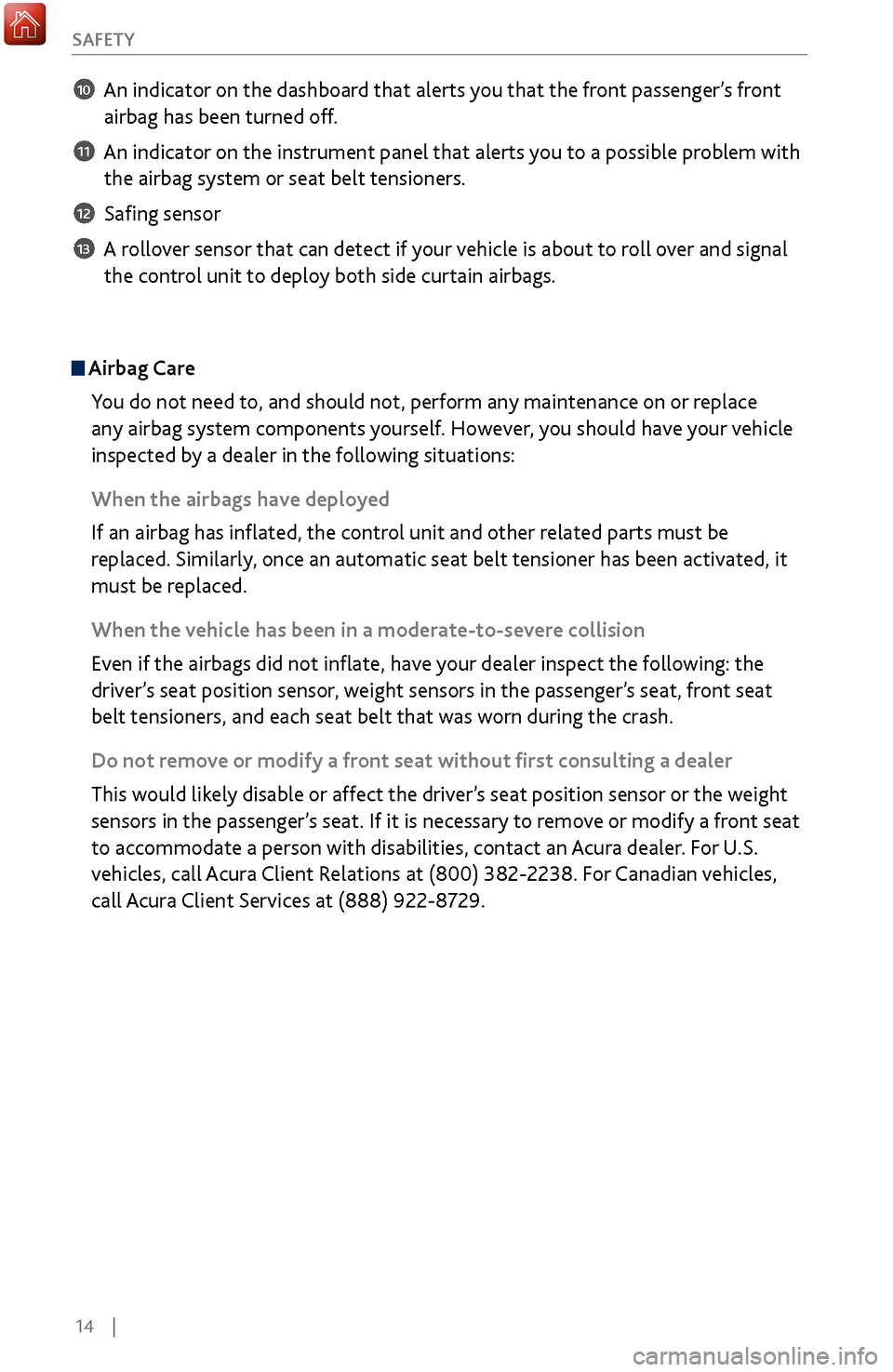
14 |
S
AFETY
10 An indicator on the dashboard that alerts you that the front passenger’s front
airbag has been turned off.
11 An indicator on the instrument panel that alerts you to a possible problem with the airbag system or seat belt tensioners.
12 Safing sensor
13 A rollover sensor that can detect if your vehicle is about to roll over and signal the control unit to deploy both side curtain airbags.
Airbag Care
You do not need to, and should not, perform any maintenance on or replace
any airbag system components yourself. However, you should have your vehicle
inspected by a dealer in the following situations:
When the airbags have deployed
If an airbag has inflated, the control unit and other related parts must be
replaced. Similarly, once an automatic seat belt tensioner has been activated, it
must be replaced.
When the vehicle has been in a moderate-to-severe collision
Even if the airbags did not inflate, have your dealer inspect the following: the
driver’s seat position sensor, weight sensors in the passenger’s seat, front seat
belt tensioners, and each seat belt that was worn during the crash.
Do not remove or modify a front seat without first consulting a dealer
This would likely disable or affect the driver’s seat position sensor or the weight
sensors in the passenger’s seat. If it is necessary to remove or modify a front seat
to accommodate a person with disabilities, contact an Acura dealer. For U.S.
vehicles, call Acura Client Relations at (800) 382-2238. For Canadian vehicles,
call Acura Client Services at (888) 922-8729.
Page 22 of 170
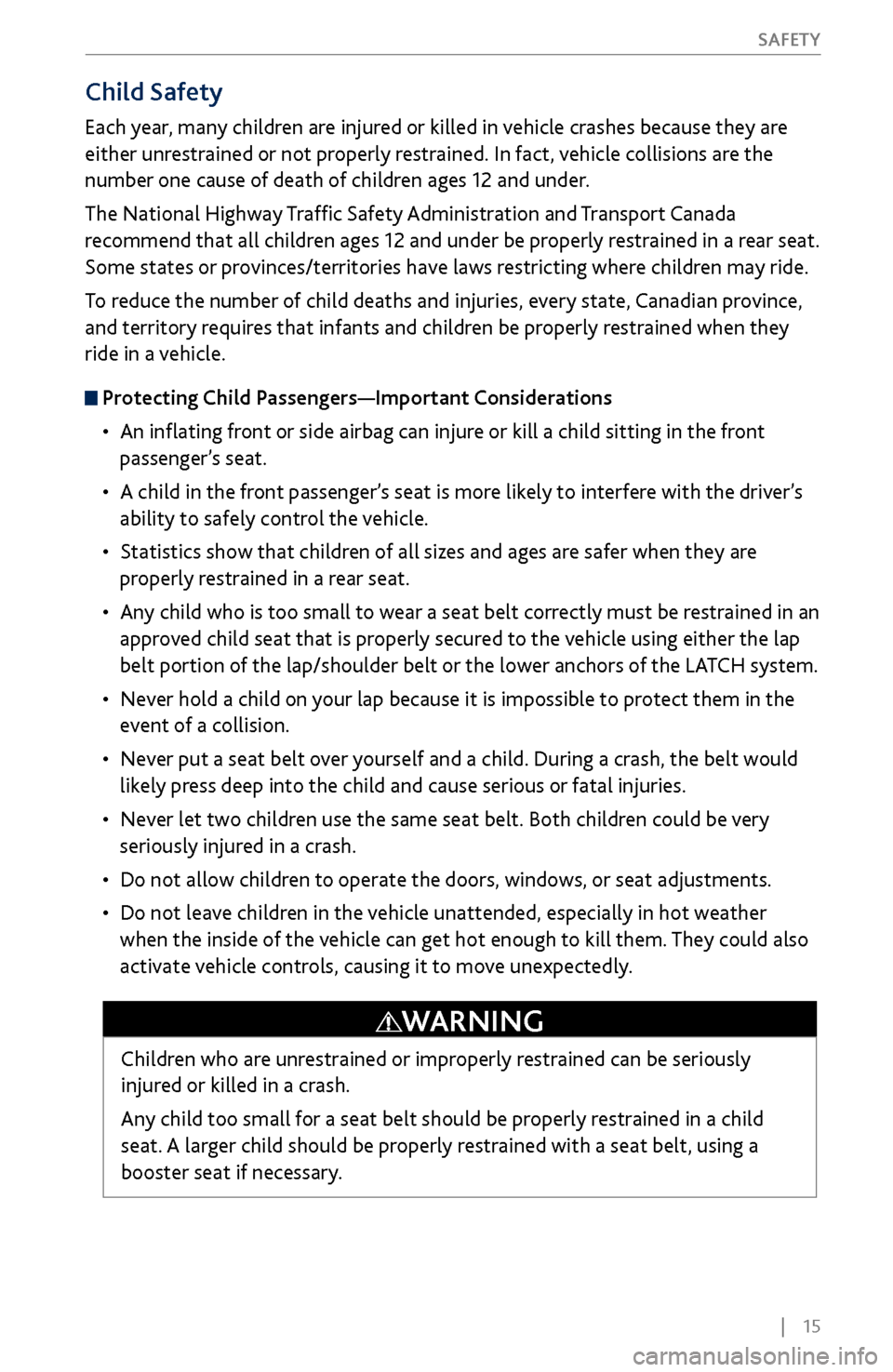
| 15
S
AFETY
Child Safety
Each year, many children are injured or killed in vehicle crashes because they are
either unrestrained or not properly restrained. In fact, vehicle collisions are the
number one cause of death of children ages 12 and under.
The National Highway Traffic Safety Administration and Transport Canada
recommend that all children ages 12 and under be properly restrained in a rear seat.
Some states or provinces/territories have laws restricting where children may ride.
To reduce the number of child deaths and injuries, every state, Canadian province,
and territory requires that infants and children be properly restrained when they
ride in a vehicle.
Protecting Child Passengers—Important Considerations
•
An inflating front
or side airbag can injure or kill a child sitting in the front
passenger’s seat.
•
A child in the fr
ont passenger’s seat is more likely to interfere with the driver’s
ability to safely control the vehicle.
•
Statistics show that children
of all sizes and ages are safer when they are
properly restrained in a rear seat.
•
Any child who is
too small to wear a seat belt correctly must be restrained in an
approved child seat that is properly secured to the vehicle using either the lap
belt portion of the lap/shoulder belt or the lower anchors of the LATCH system.
•
Never hold a child on
your lap because it is impossible to protect them in the
event of a collision.
•
Never put a seat belt o
ver yourself and a child. During a crash, the belt would
likely press deep into the child and cause serious or fatal injuries.
•
Never let two childr
en use the same seat belt. Both children could be very
seriously injured in a crash.
•
Do not allow
children to operate the doors, windows, or seat adjustments.
•
Do not leave children in
the vehicle unattended, especially in hot weather
when the inside of the vehicle can get hot enough to kill them. They could also
activate vehicle controls, causing it to move unexpectedly.
Children who are unrestrained or improperly restrained can be seriously
injured or killed in a crash.
Any child too small for a seat belt should be properly restrained in a child
seat. A larger child should be properly restrained with a seat belt, using a
booster seat if necessary.
WARNING
Page 23 of 170

16 |
S
AFETY
Protecting Infants
An infant must be properly restrained in a rear-facing, reclining child seat until
the infant reaches the seat manufacturer’s weight or height limit for the seat, and
the infant is at least one year old. Many experts recommend use of a rear-facing
seat for a child up to two years old if the child’s height and weight are appropriate
for a rear-facing seat.
Child seats must be placed and secured in a rear
seating position. Rear-facing child seats should never
be installed in a forward-facing position.
When properly installed, a rear-facing child seat may
prevent the driver or a front passenger from moving
their seat all the way back, or from locking their
seat-back in the desired position. If this occurs, we
recommend that you install the child seat directly behind the front passenger’s
seat, move the seat as far forward as needed, and leave it unoccupied. Or, you
may wish to get a smaller rear-facing child seat.
Allowing a child to play with a seat belt or wrap one around their neck can
result in serious injury or death.
Instruct children not to play with any seat belt and make sure any unused
seat belt a child can reach is buckled, fully retracted, and locked.
WARNING
Placing a rear-facing child seat in the front seat can result in serious injury or
death during a crash.
Always place a rear-facing child seat in the rear seat, not the front.
WARNING
Page 24 of 170
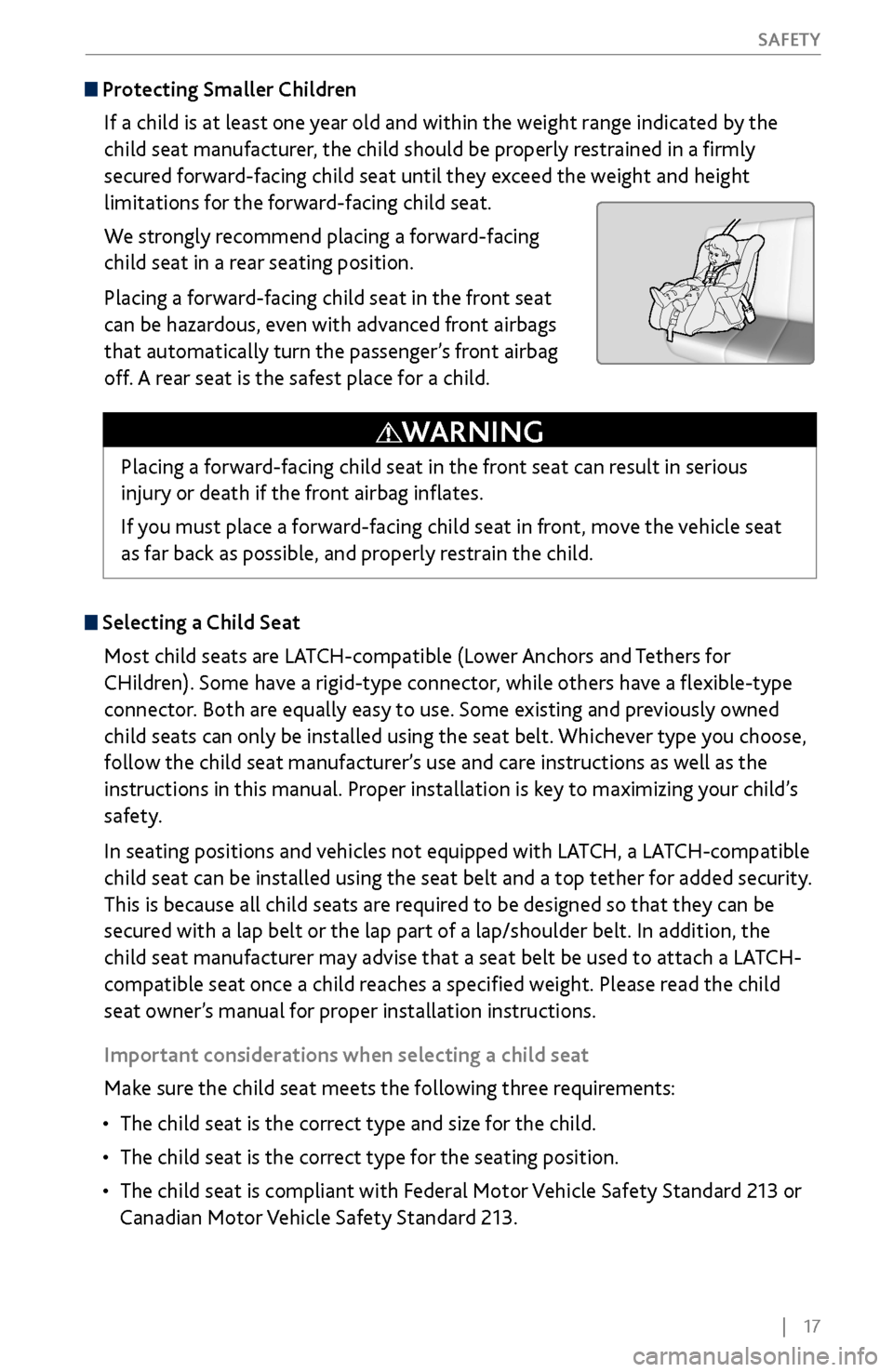
| 17
S
AFETY
Protecting Smaller Children
If a child is at least one year old and within the weight range indicated by the
child seat manufacturer, the child should be properly restrained in a firmly
secured forward-facing child seat until they exceed the weight and height
limitations for the forward-facing child seat.
We strongly recommend placing a forward-facing
child seat in a rear seating position.
Placing a forward-facing child seat in the front seat
can be hazardous, even with advanced front airbags
that automatically turn the passenger’s front airbag
off. A rear seat is the safest place for a child.
Selecting a Child Seat
Most child seats are LATCH-compatible (Lower Anchors and Tethers for
CHildren). Some have a rigid-type connector, while others have a flexible-type
connector. Both are equally easy to use. Some existing and previously owned
child seats can only be installed using the seat belt. Whichever type you choose,
follow the child seat manufacturer’s use and care instructions as well as the
instructions in this manual. Proper installation is key to maximizing your child’s
safety.
In seating positions and vehicles not equipped with LATCH, a LATCH-compatible
child seat can be installed using the seat belt and a top tether for added security.
This is because all child seats are required to be designed so that they can be
secured with a lap belt or the lap part of a lap/shoulder belt. In addition, the
child seat manufacturer may advise that a seat belt be used to attach a LATCH-
compatible seat once a child reaches a specified weight. Please read the child
seat owner’s manual for proper installation instructions.
Important considerations when selecting a child seat
Make sure the child seat meets the following three requirements:
•
The child seat is the correct
type and size for the child.
•
The child seat is the correct
type for the seating position.
•
The child seat is compliant with Federal Motor
Vehicle Safety Standard 213 or
Canadian Motor Vehicle Safety Standard 213. Placing a forward-facing child seat in the front seat can result in serious
injury or death if the front airbag inflates.
If you must place a forward-facing child seat in front, move the vehicle seat
as far back as possible, and properly restrain the child.
WARNING
Page 25 of 170
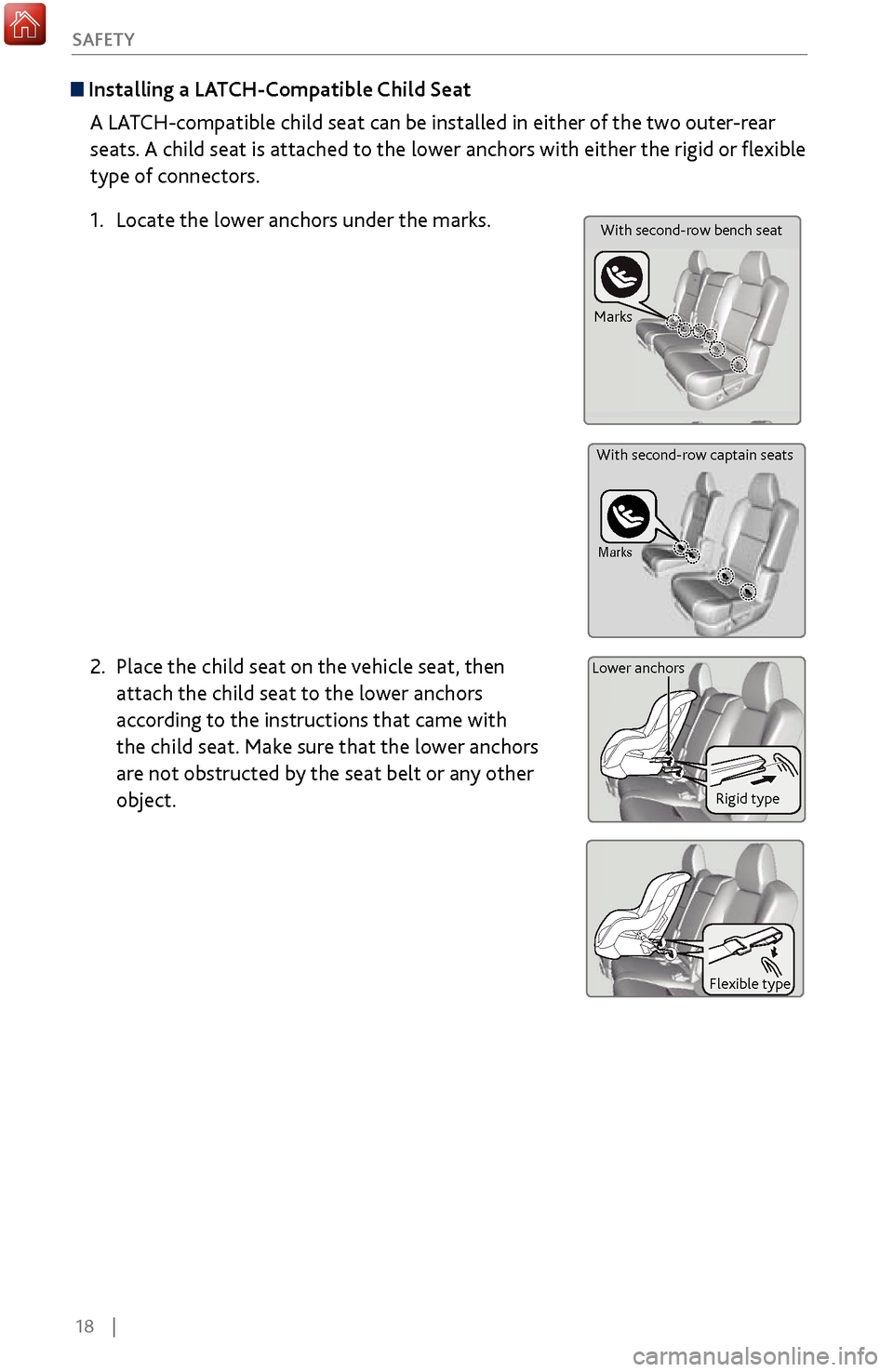
18 |
S
AFETY
Installing a LATCH-Compatible Child Seat
A LATCH-compatible child seat can be installed in either of the two outer-rear
seats. A child seat is attached to the lower anchors with either the rigid or flexible
type of connectors.
1.
Locate the lower anchors under the marks.
2.
Place the child seat on the
vehicle seat, then
attach the child seat to the lower anchors
according to the instructions that came with
the child seat. Make sure that the lower anchors
are not obstructed by the seat belt or any other
object.
Marks
Lower anchors Rigid type
Flexible type
Marks
With second-row bench seat
With second-row captain seats
Page 26 of 170
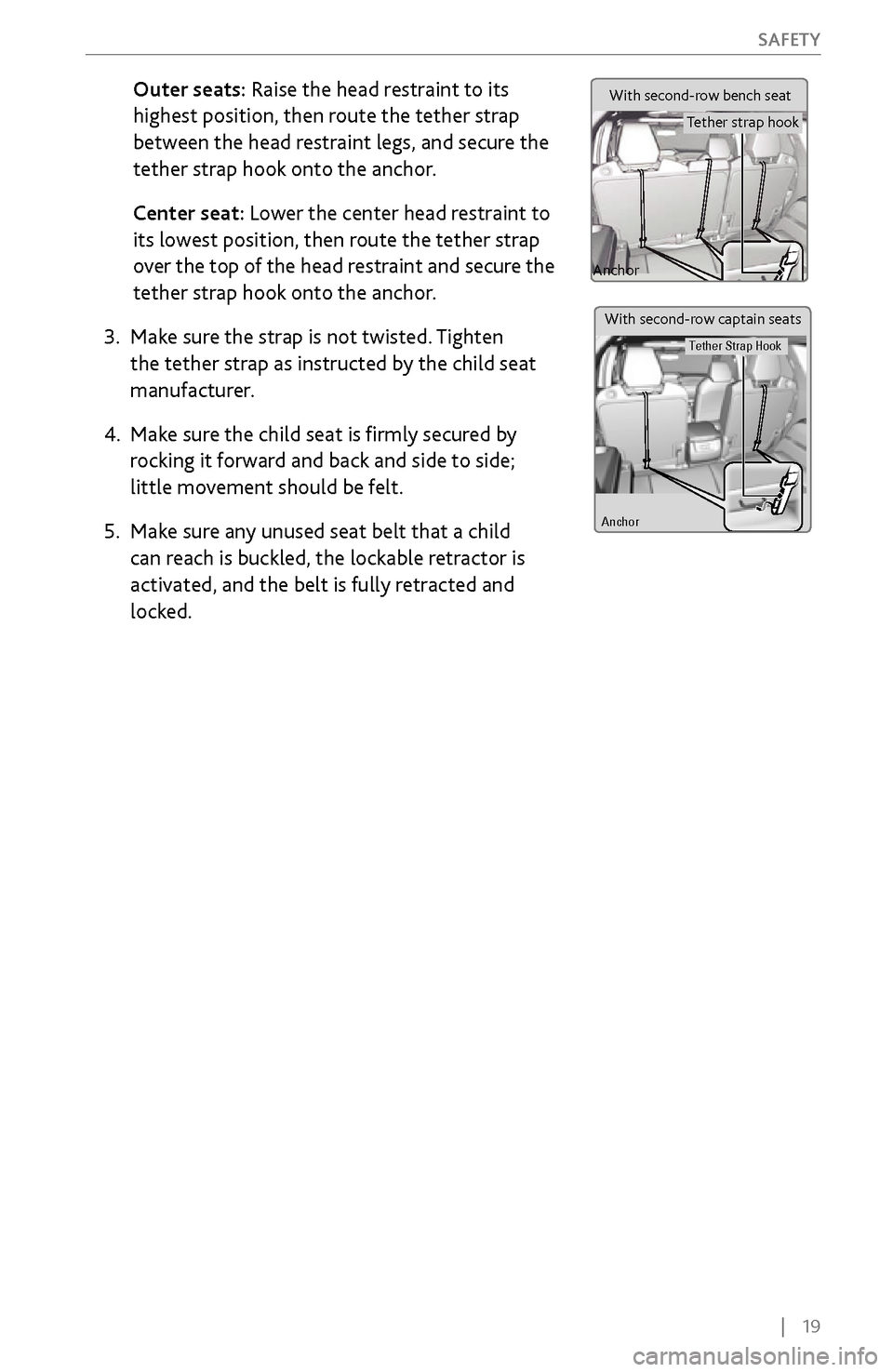
| 19
S
AFETY
Outer seats: Raise the head r
estraint to its
highest position, then route
the tether strap
between the head restraint legs, and secur
e the
tether strap hook onto the anchor
.
Center seat:
Lower the center head restraint to
its lowest position, then route
the tether strap
over the top of the
head restraint and secure the
tether strap hook onto the anchor
.
3.
Make sure
the strap is not twisted. Tighten
the tether strap as instructed by the child seat
manufacturer.
4.
Make sure
the child seat is firmly secured by
rocking it forward and back and side to side;
little movement should be felt.
5.
Make sure an
y unused seat belt that a child
can reach is buckled, the lockable retractor is
activated, and the belt is fully retracted and
locked.
Anchor
Tether Strap Hook
With second-row captain seats
With second-row bench seat
Anchor
Tether strap hook
Page 27 of 170
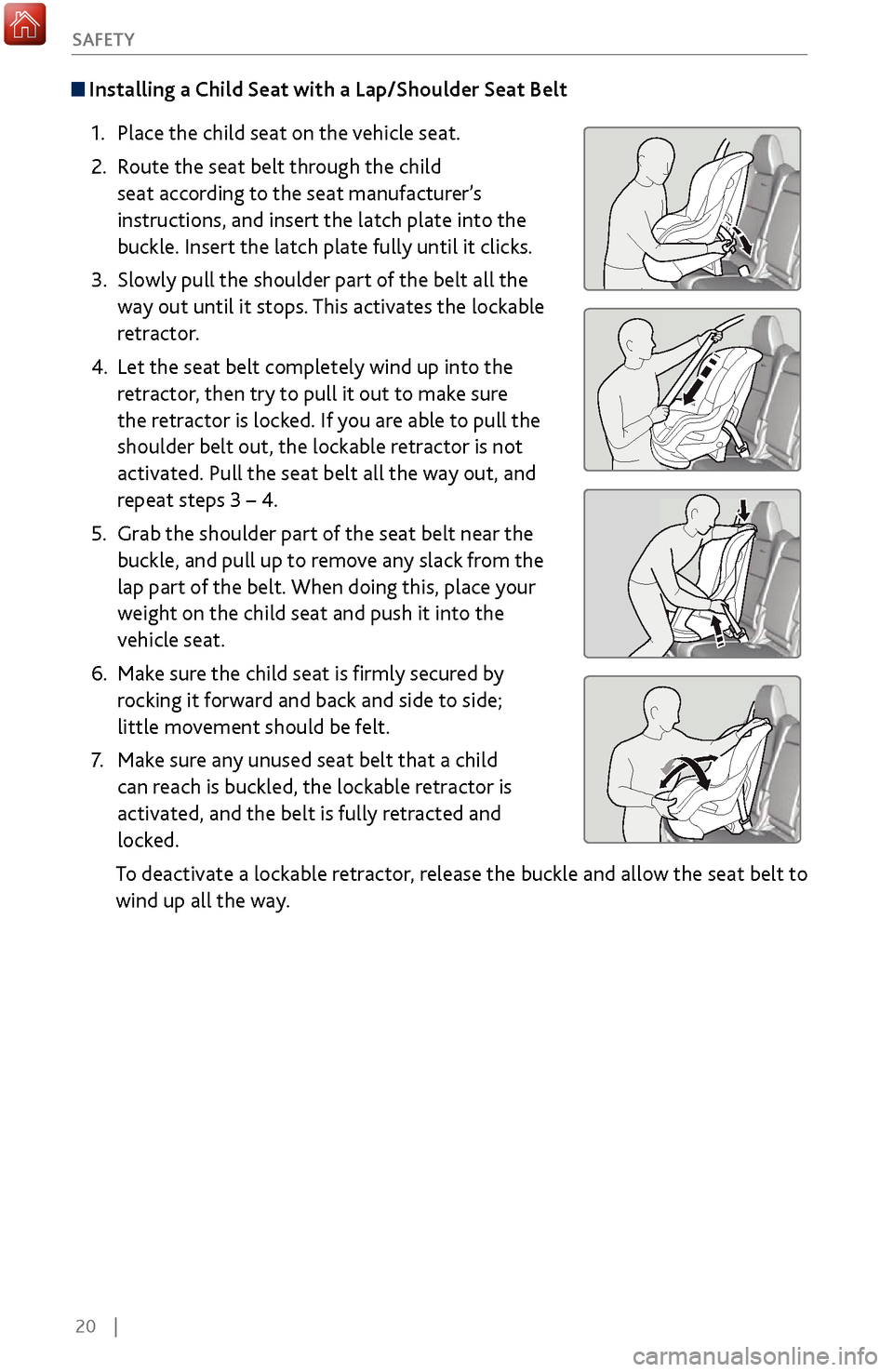
20 |
S
AFETY
Installing a Child Seat with a Lap/Shoulder Seat Belt
1.
Place the child seat on the
vehicle seat.
2.
Route the seat
belt through the child
seat according to the seat manufacturer’s
instructions, and insert the latch plate into the
buckle. Insert the latch plate fully until it clicks.
3.
Slowly pull the shoulder part
of the belt all the
way out until it stops. This activates the lockable
retractor.
4.
Let the seat belt completely
wind up into the
retractor, then try to pull it out to make sure
the retractor is locked. If you are able to pull the
shoulder belt out, the lockable retractor is not
activated. Pull the seat belt all the way out, and
repeat steps 3 – 4.
5.
Grab the shoulder part of
the seat belt near the
buckle, and pull up to remove any slack from the
lap part of the belt. When doing this, place your
weight on the child seat and push it into the
vehicle seat.
6.
Make sure
the child seat is firmly secured by
rocking it forward and back and side to side;
little movement should be felt.
7.
Make sure an
y unused seat belt that a child
can reach is buckled, the lockable retractor is
activated, and the belt is fully retracted and
locked.
To deactivate a lockable retractor, release the buckle and allow the seat belt to
wind up all the way.
Page 28 of 170
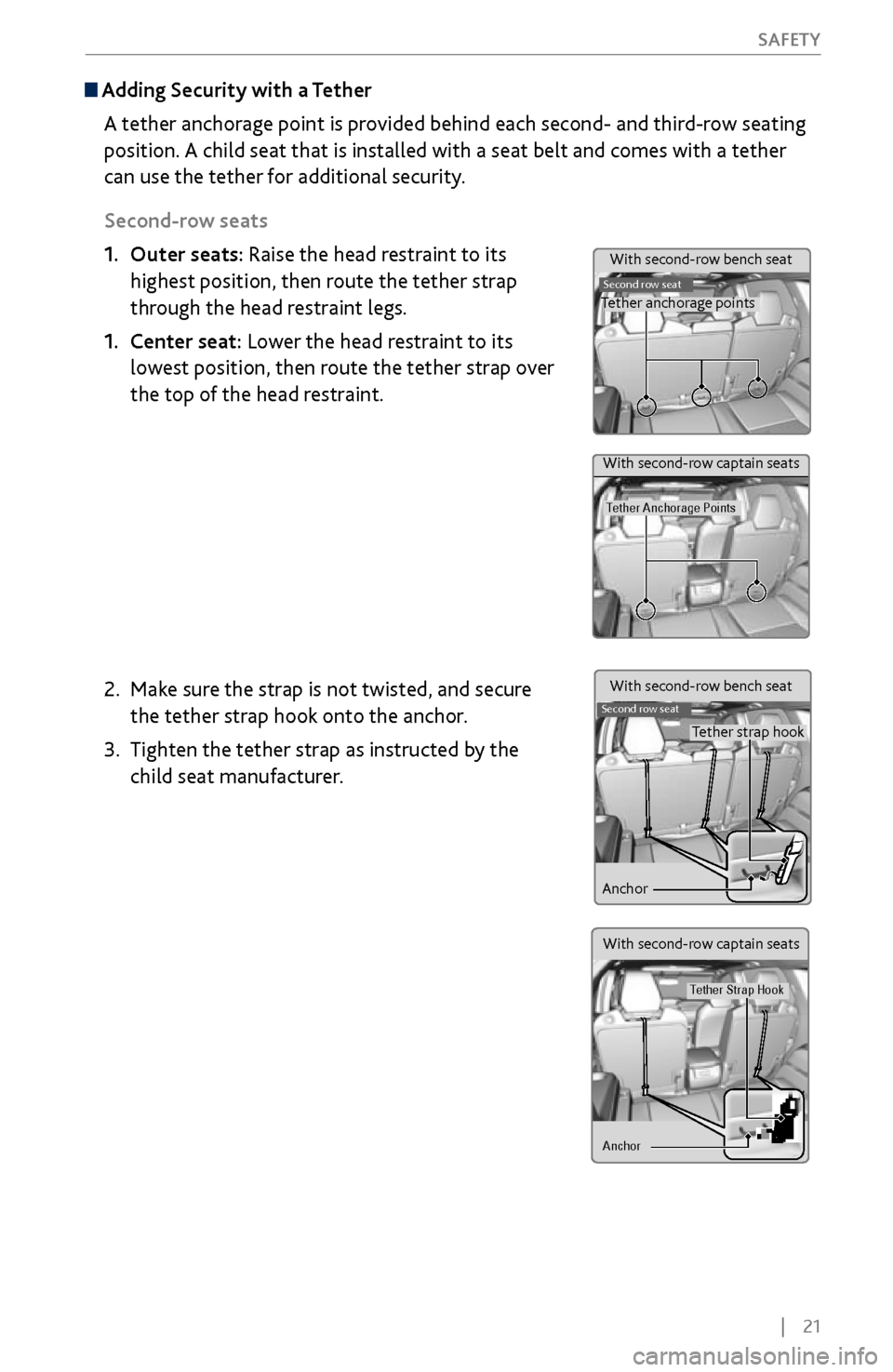
| 21
S
AFETY
Adding Security with a Tether
A tether anchorage point is provided behind each second- and third-row seating
position. A child seat that is installed with a seat belt and comes with a tether
can use the tether for additional security.
Second-row seats
1.
Outer seats: Raise the head r
estraint to its
highest position, then route the tether strap
through the head restraint legs.
1.
Center seat:
Lower the head restraint to its
lowest position, then route the tether strap over
the top of the head restraint.
2.
Make sure
the strap is not twisted, and secure
the tether strap hook onto the anchor.
3.
Tighten the tether strap as instructed b
y the
child seat manufacturer.
Second row seatTether anchorage points
Second row seat
Anchor Tether strap hook
Tether Anchorage Points
With second-row bench seat
With second-row captain seats
Anchor
Tether Strap Hook
With second-row bench seat
With second-row captain seats
Page 29 of 170
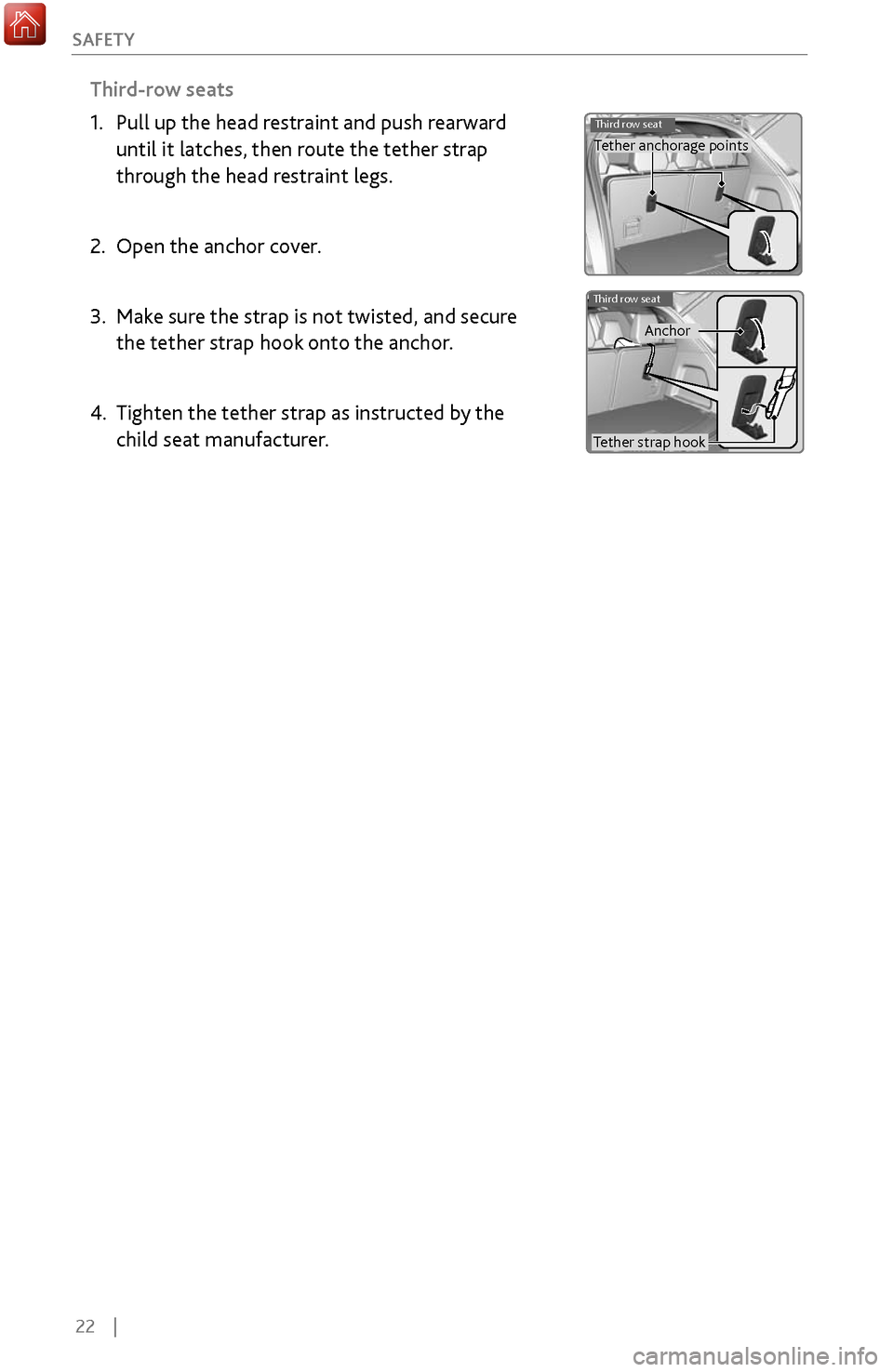
22 |
S
AFETY
Third-row seats
1.
Pull up the head restraint and push r
earward
until it latches, then route the tether strap
through the head restraint legs.
2.
Open the anchor cov
er.
3.
Make sure
the strap is not twisted, and secure
the tether strap hook onto the anchor.
4.
Tighten the tether strap as instructed b
y the
child seat manufacturer.
Third row seatTether anchorage points
Third row seat
Tether strap hook Anchor
Page 30 of 170
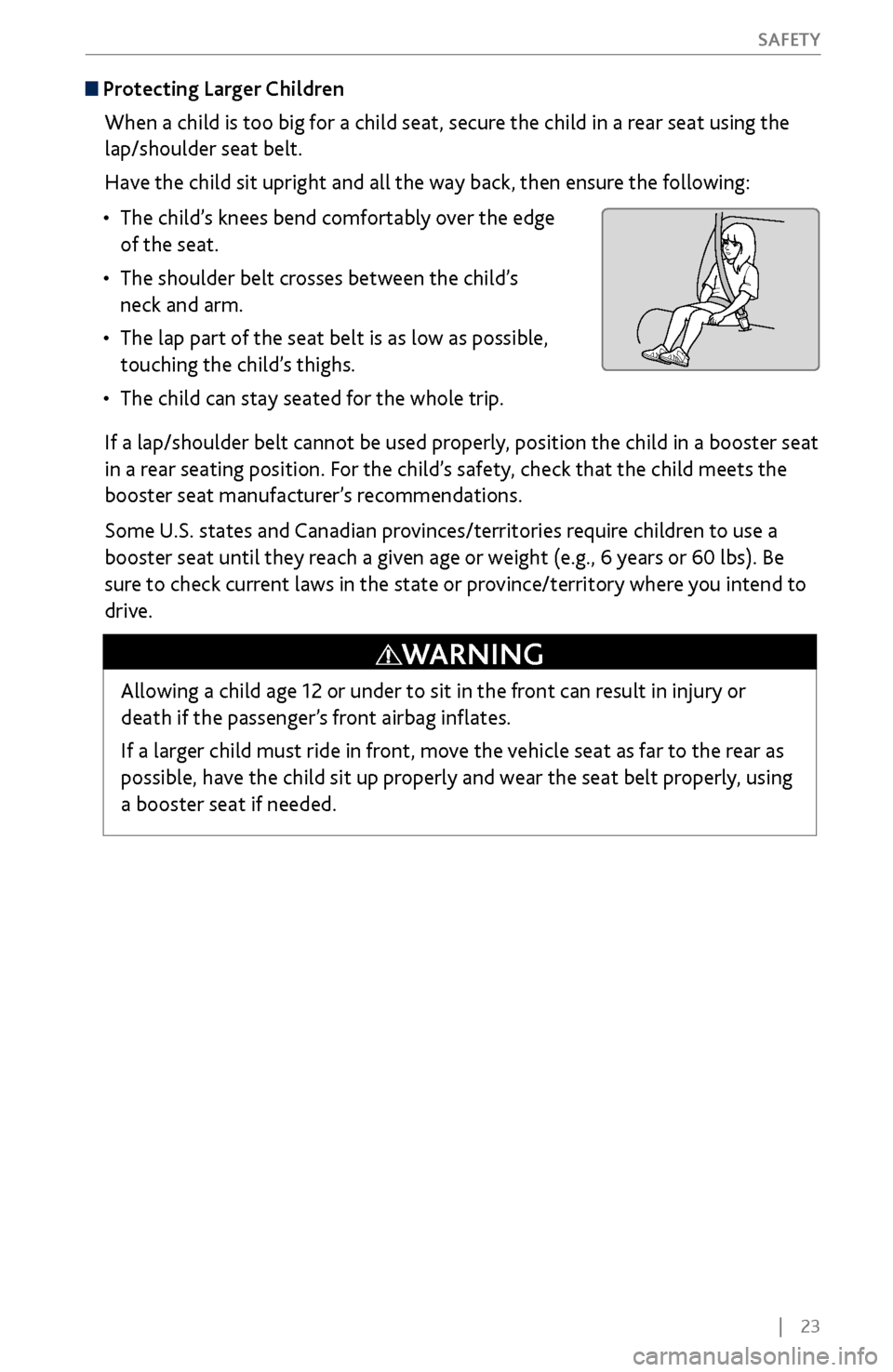
| 23
S
AFETY
Allowing a child age 12 or under to sit in the front can result in injury or
death if the passenger’s front airbag inflates.
If a larger child must ride in front, move the vehicle seat as far to the rear as
possible, have the child sit up properly and wear the seat belt properly, using
a booster seat if needed.
WARNING
Protecting Larger Children
When a child is too big for a child seat, secure the child in a rear seat using the
lap/shoulder seat belt.
Have the child sit upright and all the way back, then ensure the following:
•
The child’s knees bend comfortably
over the edge
of the seat.
•
The shoulder belt crosses between the child’
s
neck and arm.
•
The lap part of the seat belt is as low as possible,
touching the
child’s thighs.
•
The child can stay seated for the
whole trip.
If a lap/shoulder belt cannot be used properly, position the child in a booster seat
in a rear seating position. For the child’s safety, check that the child meets the
booster seat manufacturer’s recommendations.
Some U.S. states and Canadian provinces/territories require children to use a
booster seat until they reach a given age or weight (e.g., 6 years or 60 lbs). Be
sure to check current laws in the state or province/territory where you intend to
drive.